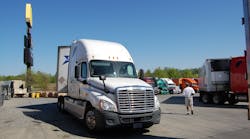Changes made to hours of service (HOS) rules back in July combined with the potential for electronic logging device (ELD) mandates may eliminate a source of “flexibility” used by the trucking industry to meet ever tighter just-in-time (JIT) shipper deliver requirements, according to experts.
In a recent investor report, John Larkin managing director and head of transportation capital markets research for investment banker Stifel, Nicolaus & Co., stated that 80% of truckload carriers say they are experiencing a loss of productivity from the recent HOS rule changes, according to a recent survey, with 67% of truck drivers witnessing a negative impact of 3.2% to 7.7% on wages due to those same alternations to HOS regulations – a loss that equates to $1.6 billion to $3.9 billion annually.
Though Larkin added that the trucking industry may not see fully implemented and mandatory ELDs until the end of 2016 or beyond, as there is typically a 3-year period between a notice for proposed rulemaking and the compliance date, such devices could remove further “flexibility” from the truck transport system, he added.
“With an estimated 30% to 40% of the tractors in the U.S. currently utilizing ELDs, the remaining 60% to 70% using paper logs continue to maintain some ‘flexibility’ around HOS rules and other FMCSA regulations – essentially being able to pull-off moves that some shippers need,” Larkin explained in his comments. “Interestingly, one shipper noted that as the ELD adoption rate has increased, they have seen incremental drops in service levels.”
He added that while few shippers using dry van trucking services are reporting any HOS-related rate increase proposals, there’s been some increased the use of brokers as a result of trucking productivity losses.
Additionally, Larkin stressed that carriers are saying any “flex time” previously built into the transportation network has “collapsed” due to the mandatory 30 minute rest period—creating risk in service levels.
“To help combat this, some shippers have become more flexible,” he explained. “On the other hand, one predominantly reefer shipper noted they have seen rate impacts attributable to the new HOS to the tune of 2%. The total increase was roughly 8%, and did not include transportation timing delays stemming from one-day transits that can no longer be made because of the mandatory rest period. Overall, this shipper has not seen capacity come down, but the new HOS made its challenging lanes that much worse.”
Joe Cowan, president of Cowan Systems, noted at the recent Infrastructure of the Future summit that adhering to current on-time delivery metrics for trucking services under the current rules will be extremely difficult.
“The standard that our company has to meet to compete in the country today is 98% on-time delivery percentage,” he said. “But to allow for my driver to make it from point A to point B on time, I’ve to allow for all kinds of contingencies so [shipments] are on time. So the reality is, I’m never on time, I’ve always got to be early because there are just too many problems that arise.”
At the same event, Mathew Shay, president of the National Retail Federation, pointed out that HOS changes – along with other regulatory efforts – are “harming” supply chain efficiency.
“The complicated nature of these regulations is stunning,” he said. “Many of these rules are in conflict with one another or at the very least causing confusion between them.”
Stifle’s Larkin believes, however, that in the “truckload slice of the transportation pie” at least the recent changes to HOS are not as yet having a large enough capacity tightening effect to drive rate increases—at least in the dry van sector.
That being said, Larkin said the implementation and enforcement of mandatory ELDs on the entire U.S. tractor fleet – coupled with additional regulations coming down the pipeline, continued cost increases such as to insurance, maintenance, et cetera, plus higher equipment life-cycle costs and scarce financing – leads him to believe smaller truckload fleet operators in particular will find the freight business environment very challenging over the next five to 10 years.



